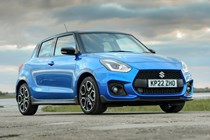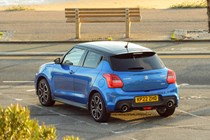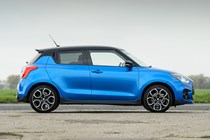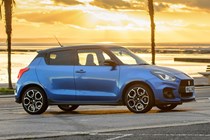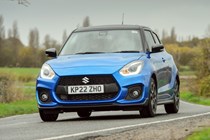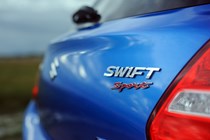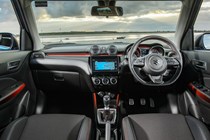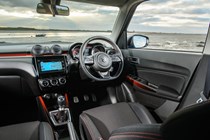
Suzuki Swift Sport (2018-2024) long-term test
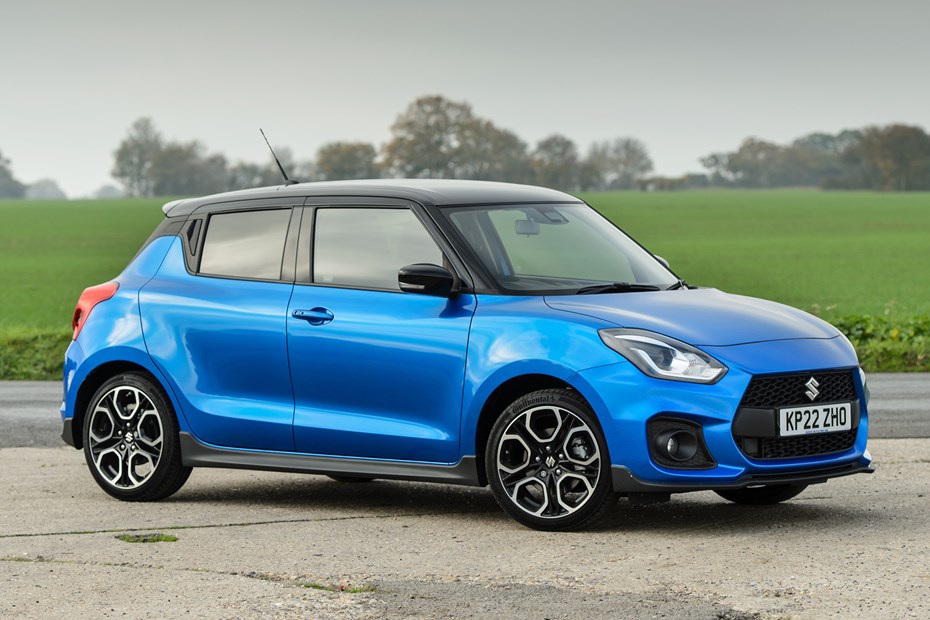
Suzuki must have taken inspiration from Lotus when it designed the Swift Sport, because it sticks closely to the British brand’s mantra of “simplify and add lightness.” Its panels are made from wafer-thin metal, its interior has just enough equipment to be comfortable and, although its engine isn’t as powerful as rivals like the Ford Fiesta ST and MINI Cooper S, it makes up for that by being around 200kg lighter. It’s pretty fuel efficient, too, thanks to mild hybrid assistance. We have months of updates ahead to let you know what the Swift Sport is like to live with day-to-day.
Reports by Luke Wilkinson
Update 1: Welcome
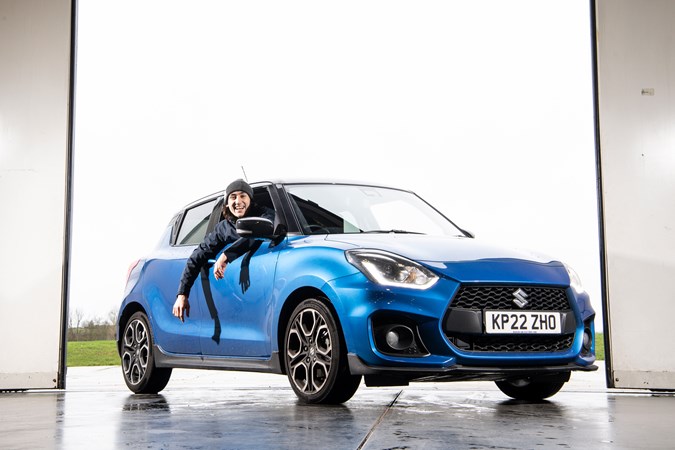
I’m quite loud. My friends and family often joke that I should get a part-time job at the local harbour, standing in for the foghorn when it’s broken. And, when Suzuki offered me a Swift Sport long-termer, I proved their jests were based on fact. My excited bawls were heard in the neighbouring town.
I’ve been a fan of the Swift Sport since I first drove one in 2019 because it offers almost everything I look for in a car. It’s small, lightweight, turbocharged, reasonably fast and it has a manual gearbox. That makes it perfect for darting along the narrow country lanes of my home county, Cumbria.
However, I got cold feet as the Swift Sport’s delivery date drew nearer. Suzuki updated the car in 2020, swapping its original 140hp 1.4-litre petrol engine for a more efficient but heavier and less potent mild hybrid unit. The change tipped the car’s kerb weight over a tonne and hacked around 10hp off its maximum output – and I was concerned that would ruin the experience.
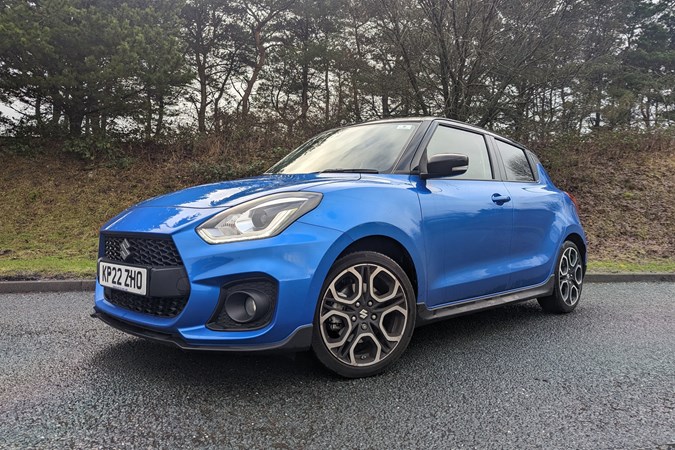
To find out whether it had, I took the Swift Sport on a long drive from London to my family home on the outskirts of the Lake District. If you’ve read my work before, you’ll know this is my default method of gauging my opinion on a car. By the time I’ve spent six hours and 300-odd miles in the saddle, I’ve normally found all the irritating problems a car can throw up.
I’d barely escaped the strangling embrace of the North Circular before I found the first red flag – the range. At this point in the journey, my family home was more than 320 miles away, but the trip computer was telling me that I would run the tank dry in just 270. After consulting the spec sheet, I found the Swift only has a 37-litre tank, which is five litres less than you get in a Fiesta ST.
That’s less than ideal – and the Swift’s fuel thimble forced me to make a splash-and-dash pit stop in Tempsford to dodge those famously exorbitant motorway service station fuel prices. At least Suzuki’s new mild hybrid system is economical. I averaged around 47mpg on the motorway and roughly 44mpg once I turned onto Cumbria’s wiggly backwaters. So at least it makes the most of what it has.

The Swift is also surprisingly comfortable on the motorway. It’s a small, lightweight car, but it copes admirably well with crosswinds and it doesn’t get unsettled when the wake of a passing lorry washes over it. And, because it’s quite delicate, Suzuki hasn’t needed to fit rock-hard suspension to control the body. There’s less inertia to counteract when you tip it into a corner, so the springs are rather soft – and that means it breezes over bumps with a little more ease than a Fiesta ST or an i20 N.
Because it hasn’t been set up like a touring car, you can drive the Swift Sport with a bit more vigour on country roads, safe in the knowledge you’re not going to bash the sump into the tarmac when you drop into a dip. And because it only has 129hp, you can drive it hard within the bounds of the law, which makes it entertaining every day.
However, I’m not stuck on the steering. Maybe I just haven’t got used to it yet, but I reckon it’s overly assisted for a hot hatchback. It’s very light around the centre, too. There’s enough feedback, though, and it does a better job of transmitting the texture of the road surface into your fingertips than an i20 N. I’ll let you know if I come to terms with it in a few weeks.
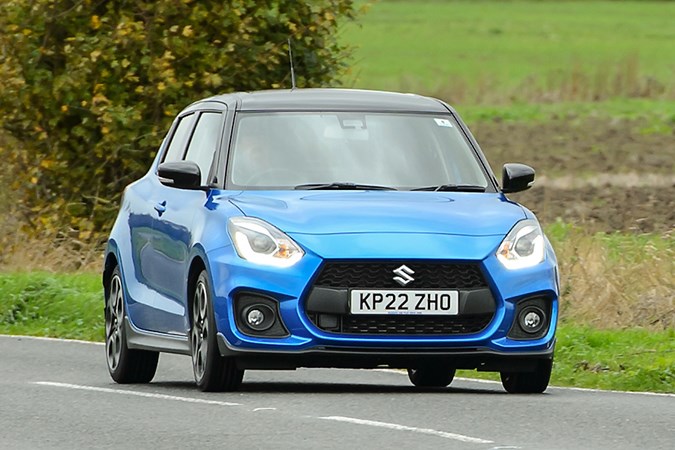
I have one last complaint for now, and then I’ll let you get on with your day. It’s the safety systems. I didn’t see eye-to-eye with Suzuki’s safety suite in my old long-term S-Cross – and it saddens me to report that the Swift Sport shares the same faults.
Its front collision warning system screams like a boiling lobster if you get within 10 miles of a parked car and it has a sensitive seat belt warning system that can sometimes recognise loose items on the rear bench as passengers. The dashboard will then buzz like a mosquito until you pull over and buckle them up.
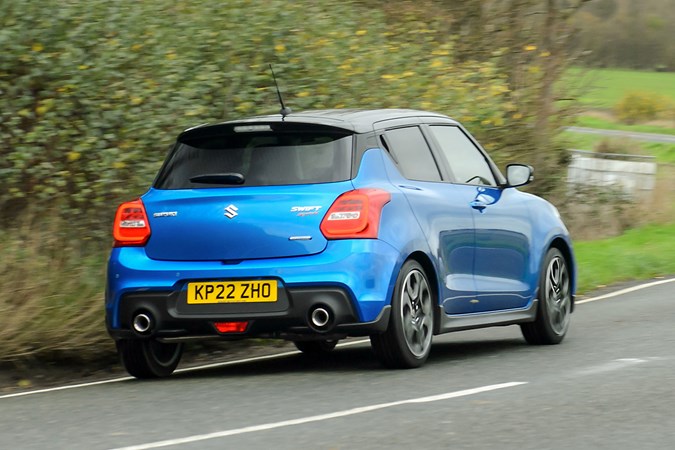
You can turn the front collision warning system off, but there’s no escape from the seat belt warning chime. It’s particularly annoying if you’re heading out on a big trip. You might need to use the rear bench to store your luggage because the boot is so small – and it normally isn’t until you hit the motorway that the weight sensors trip and the buzzer starts its chorus.
Overall, though, I’ve thoroughly enjoyed my first couple of weeks with the Swift Sport. I’ll update you again soon with some more info on its practicality. My girlfriend and I are about to move house and we’re planning to use the Swift Sport to shift the last couple of boxes to our new address. So, I’ll have a very delicate game of real-life Tetris to recount in the next fortnight. Stay tuned.
Mileage: 3,564
Average fuel economy: 44.6mpg
Update 2: Practicality
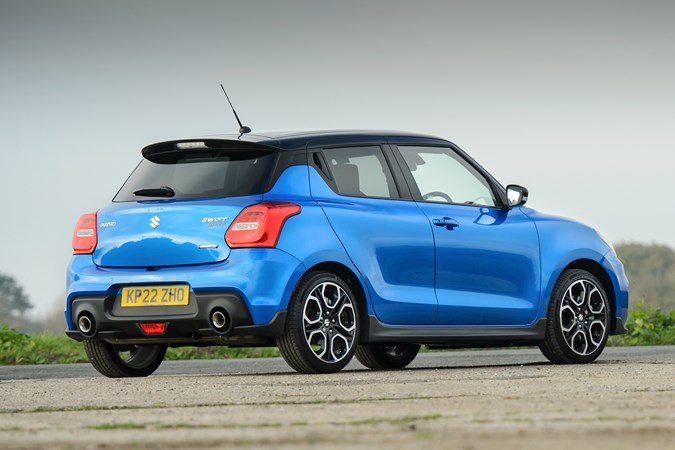
I was a little apprehensive about writing this update. The night before I started, a spectre visited me in a dream, warning me of the vehement torrent of emails I would receive once the words went live.
“You’re an idiot, Luke,” they’d read. “The Swift Sport isn’t practical! We’ve seen the reviews – we already know it has cramped rear seats and a miserly 265-litre boot! We’ve owned suitcases with more storage space! And my hipflask could hold more fuel than its tiny petrol tank, for God’s sake! Only a moron would take the Swift Sport over a Fiesta ST!” Etcetera, etcetera.
But I laugh in the face of naysayers. I accept the Swift Sport is flawed, but I believe its practicality limitations can be overcome with sacrifice, ingenuity and persistence. There’s no need to rush out and buy an enormous SUV because you might need to carry a chest of drawers in the next five years and you want to be comfortable on that day. Just use the car you have and live with the temporary inconvenience. Especially if you enjoy driving.
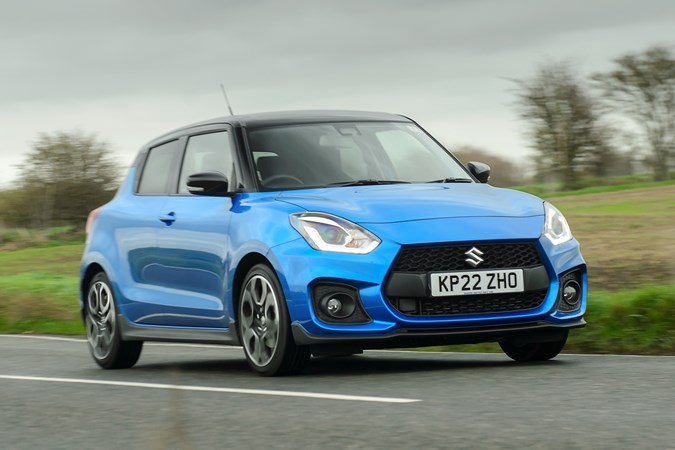
I mentioned in my previous update that my girlfriend and I are about to move house. We’ve divvied up the admin and I was tasked with sourcing the cardboard boxes for our stuff. So, while I was up north visiting my family for Christmas, I took advantage of the goodwill of the Cumbrian public.
My Dad’s a well-known decorator in the area and he knew there’d be plenty of spare cardboard boxes in his local painters’ merchants. So, we piled into his van like a budget version of Starsky and Hutch, kicking down the doors of every trade supplier in West Cumbria to confiscate the contents of their recycling bins.
In hindsight, we should have done the job in the Swift. The van has loads of space, so we finished our tour with way more boxes than I needed, as soon became obvious when we saw the look on my Mam’s face when Dad unloaded the contents of his Toyota Proace into the front porch. There was one word to describe it – an avalanche. And then it dawned on me that I’d need to squeeze this pallet of cardboard into a supermini with a boot barely big enough to hold my suitcase.

I made a sacrifice. I wasn’t carrying passengers, so I piled the rear seats high. I found the boxes fit into the space more effectively with the bench in place, because there’s a three-inch step between the boot floor and the seat back once you’ve folded it down. That pushes your cargo up towards the roof and obscures your view out of the rear window, which isn’t ideal on the motorway.
This was good, but it wasn’t enough. So, I engaged my ingenuity and jiggled the front passenger seat backwards and forwards until I’d liberated enough space in the front and rear footwells to fit both a bag of Christmas presents and some shock-absorbing packaging.
That still wasn’t enough, though, so I deployed my “persistence.” Full disclaimer – I’m using that noun as a euphemism for brute force and ignorance. Just ram the gear in, slam the doors and hope they aren’t forced open by the weight of the cargo pressing against them. And it worked!
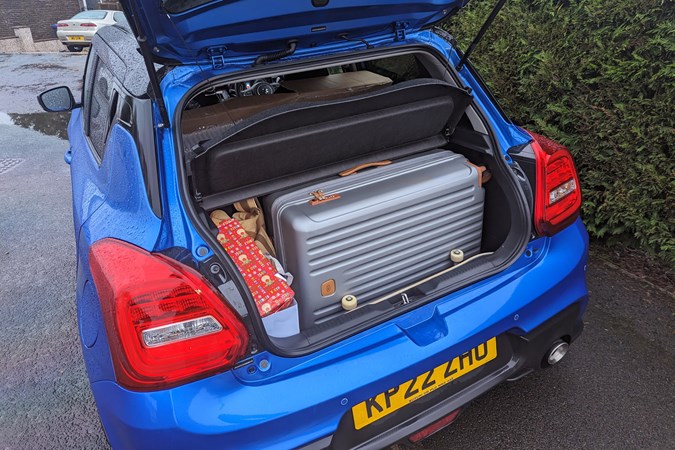
This little supermini swallowed all my luggage, Christmas presents, a skateboard, a new vacuum cleaner plus enough packing materials to parcel up Sandringham and still have enough left over to make a start on moving Andrew out of Windsor and into exile. And, when it isn’t moonlighting as a courier van, it’s still a Swift Sport – which means it’s great fun to drive. Way better than most SUVs, that’s for certain.
It’s also a good way to break the ice with fellow petrol heads, as I found out on my return journey to London. I stopped at Tebay services for a bacon sandwich and a coffee, because Tebay services are the best services in the UK. Don’t bother getting in touch with your suggestions on superior motorway cafés – you’re wrong and you should learn to accept it.
When I pulled into the car park, famished and exhausted by the crippling 50-mile drive from my parents’ home, I spotted this immaculate Rover 216 GTi. So, I did what any car enthusiast would do and parked alongside for a gander and a photo.

As I was admiring it (completely dumbfounded by its total lack of rust), the owner sidled up to me for a natter. He’d spied me from the café and came outside to give me the full tour. Turns out it’d been in storage for several years. He found it, made it roadworthy, fitted a very attractive set of six-spoke alloys and then dropped the suspension by three inches to complete the look.
It was immaculate and it ran like a sewing machine. There was one problem, though. The exhaust manifold had a slight leak – and he was using it to drive his missus and his mother-in-law down south. They were getting choked by the fumes, so they were forced to drive down the motorway with all the windows open to get some fresh air into the cabin. It certainly gave them a story to tell, but hearing it made me more grateful for the Swift.
Chatting with the owner of this 216 GTi also gave me some perspective on how much hot hatchbacks have improved in the past two decades. Now, they’re more reliable, more powerful, more fuel efficient and more practical – a point that was reaffirmed as I watched the chap’s poor wife shoehorn herself into the rear of the Rover, bashing her head into the B-pillar on her way in.

The Swift Sport might not be the best option in its segment, but it isn’t that far behind the current class-leaders in the real world. As I’ve shown here, it’s also much more practical than its dimensions would suggest, especially if you’re prepared to do a bit of lateral thinking. So don’t discredit it simply because the figures don’t look as impressive on paper alongside its rivals. You’ll be surprised what the Swift Sport can do once you start living with it.
Mileage: 4,199
Average fuel economy: 41.5mpg
Update 3: head-to-head
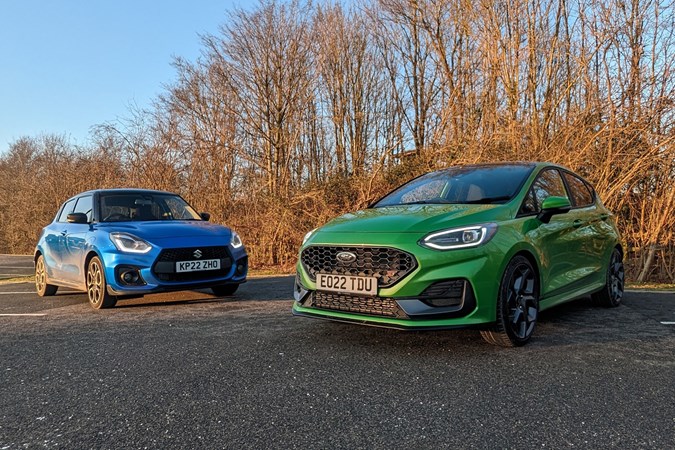
The hot hatchback market is a shadow of its former self – and it’s all down to economics. It’s been in a steady state of decline for around a decade now, following the change in buying attitudes that saw SUVs replace hatchbacks as the default mode of private transport in the UK.
The data tells the story. During the first two months of 2023, eight of the top 10 best-selling cars in the UK were SUVs. If I was the boss of a big car company, I wouldn’t spend money on developing a new small hatchback – let alone a performance model. I wouldn’t sell any.
It’s good that manufacturers are adapting their line-ups to stay afloat, but the change is bad news for car enthusiasts. I’ve stood by helplessly as the heroes of my hometown’s boy-racer scene have been cut from the showrooms like a cancer. Cars like the Vauxhall Corsa VXR, Peugeot 208 GTi and Renaultsport Clio have all been discontinued – and I’ve been watching them fade with the same sense of wistful sorrow I have for my favourite classic metal artists.
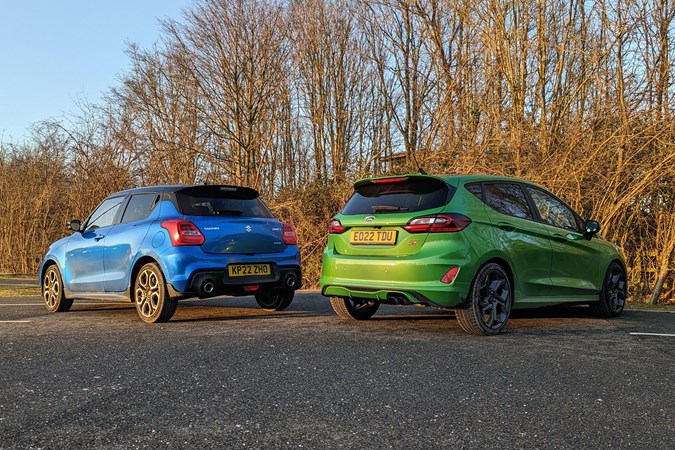
Even the class-leading Ford Fiesta ST (which, I’m sure you’ll agree, is the Ronnie James Dio of the small hot hatchback world) will be pushed through the pearly gates in June 2023. So, before Ford pulls it from sale, I thought it would be useful to spend some time comparing it with one of the few remaining small hot hatches with a secure future – my Suzuki Swift Sport.
Our sister title, CAR magazine, has already spotted the next-generation Suzuki Swift tackling its development programme ahead of its scheduled launch in 2024. It also reports that a replacement for the Swift Sport is on the way.
Now that the Fiesta ST’s neck is on the chopping block, Suzuki could end up swallowing Ford’s market share. It sounds like the Japanese brand will try to lure performance fans in with a more powerful 160hp version of its 1.4-litre mild hybrid petrol engine.
What’s more, now that giants like Ford and Renault are spending less money on hot hatchbacks and more money on EVs, the new Swift Sport could soon find itself sitting near the top of the market. But that’s a discussion for next year. The question for today is: how does the current Suzuki Swift Sport compare to the swansong Ford Fiesta ST?
Performance
We’ll tackle the biggest issue first. The Fiesta ST is much faster than the Swift Sport. The Ford’s engine might only have three cylinders to the Suzuki’s four, but it has a slightly larger displacement and a much bigger turbo, resulting in a staggering amount of torque. There’s 320Nm to be exact, which is a whopping 95Nm more than you get in the Suzuki.
The results are irrefutable. Even though the Swift Sport is more than 200kg lighter, the Fiesta ST will saunter away from it in a straight line – and that makes the Ford much more exciting. Performance is rather subdued until around 3,000rpm, at which point the turbocharger wakes up and launches the ST at the horizon like a lime green missile.
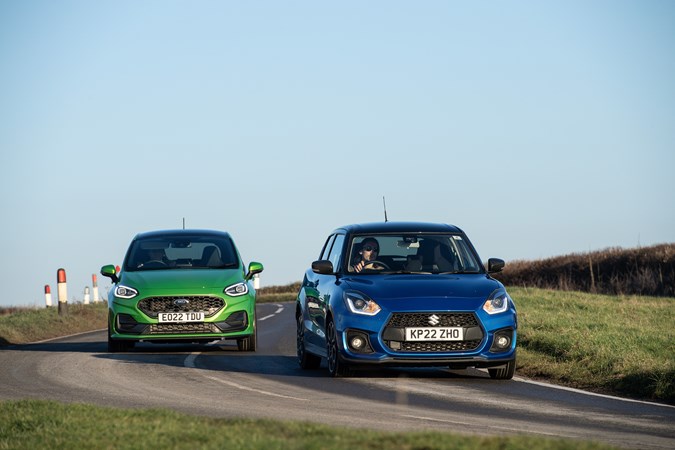
The Swift’s engine doesn’t rely quite so heavily on its turbocharger, which makes it easier to drive. If you drop off the boost the engine’s mild-hybrid system will kick in, helping to turn the engine over and counteract the dip in performance before the boost loads again. You get a little light on the dashboard to let you know when the electric motor is spinning, which is quite fun.
That means the Swift’s power comes earlier in the rev-range – and that gives you a golden (and rather small) window of opportunity to close ground on the Fiesta ST. While the Ford is crawling up to its power band, the Suzuki is already torching its tyres. If the Fiesta driver misses a shift, the Swift will claw back a few yards before its rival’s turbo comes on song.
Handling
The Fiesta might have the legs on the straights, but I was surprised by how close the competition was in the corners. I didn’t think the Swift would stand a chance because its tyres are much narrower and its suspension is far softer. Compared to the ST, I expected it to wobble around the road like a wheeled jelly. But it didn’t.
Here’s where the Swift’s baby bird build brief comes into play. It doesn’t need cast iron dampers and obsidian springs because the chassis isn’t fighting against a heavy car. As such, there’s still plenty of grip and good resistance to understeer. The Swift’s body rolls more than the Fiesta’s but there’s no extra inertia to drag the car away from its line, so the two cars end up being quite evenly matched.
The Suzuki’s steering isn’t as sharp as the Ford’s, though. I still think the Swift’s setup is a bit overly assisted and it doesn’t communicate where the front wheels are pointing with the same accuracy. However, the Swift transmits the texture of the road into your palms better than the Fiesta.
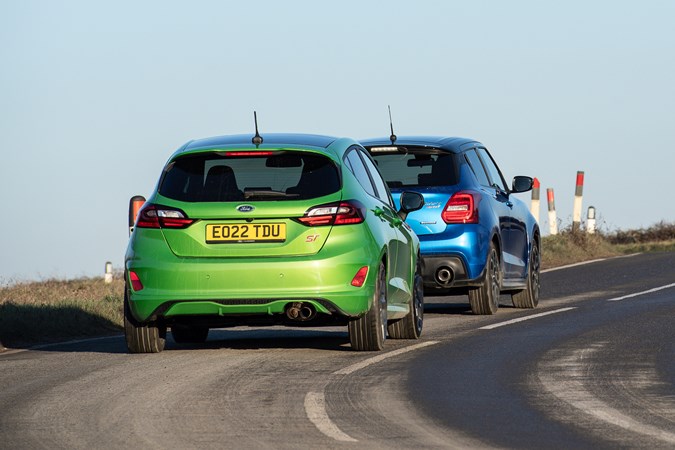
Both cars have good brakes. The Fiesta’s discs and calipers are bigger, so they offer an immense amount of stopping force. But, again, the Suzuki’s smaller discs have less bulk to rein in. If you really stood on them, I reckon it would pull up in the same distance as the Fiesta. I also much prefer the feel of the Swift’s brake pedal. It has a better bite and it’s closer to the accelerator, which makes it easier to do heel-and-toe downshifts when braking for tight corners.
Just bear in mind that these observations were all gathered on the road. I’m sure that if you press-ganged a couple of racing drivers and rented a circuit, the Fiesta would be superior. But, on an average UK road with average drivers, the Suzuki can hold its own against the best.
Which one should you buy?
Well, that depends on what you want from your hot hatchback. The Fiesta ST is quick no matter who’s driving it, whereas the Swift Sport requires a little more talent to get the best out of it because it’s so down on power. It’s the classic battle between brute force and lightness.
However, because it’s weedier, you can use more of the Suzuki’s performance more of the time and not worry about losing your license. Slingshot down a motorway slip road at full noise in third gear in the Swift Sport and you’ll be doing the speed limit by the time you join the carriageway. Do the same in the Fiesta ST and you’ll be flying dangerously close to a driving ban.
It’s always more fun to drive a slow car fast than a fast car slow. For that reason, despite the Fiesta’s characterful engine, intoxicating performance and better build quality, I still think I prefer the Swift. It’s cheaper, it’s slower and it isn’t particularly refined – and that makes it feel a lot like the sorts of cars my friends and I were razzing around in when we first passed our tests.
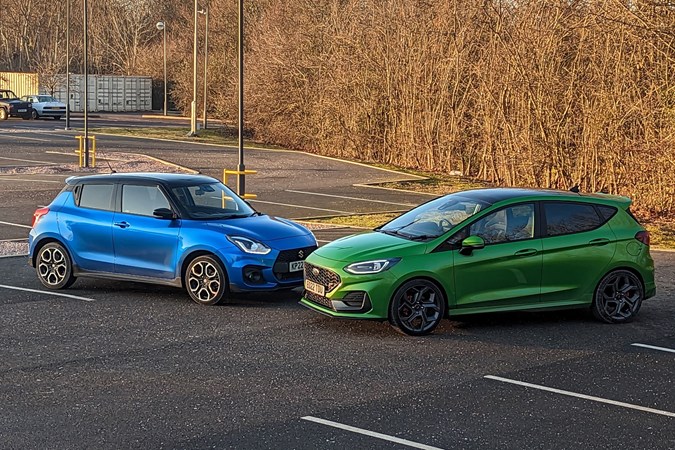
While nostalgia might be a powerful selling point, a cheaper sticker price is better still. Let’s not forget that the Fiesta ST is more than £4,000 more expensive than the Swift Sport – and I’m not convinced that you’ll get your worth out of the extra performance on the public roads.
It makes me very sad to see the Fiesta ST get put out to pasture, but I’m excited about Suzuki’s plans for the next Swift. Until now, Ford has guarded the small hot hatch trophy closely, but it can’t defend its title if it doesn’t show up to the competition. Who knows? When the next Swift Sport hits the market in 2024, it might find itself the new favourite.
Mileage: 5,100
Average fuel economy: 42.3mpg
Update 4: maintenance
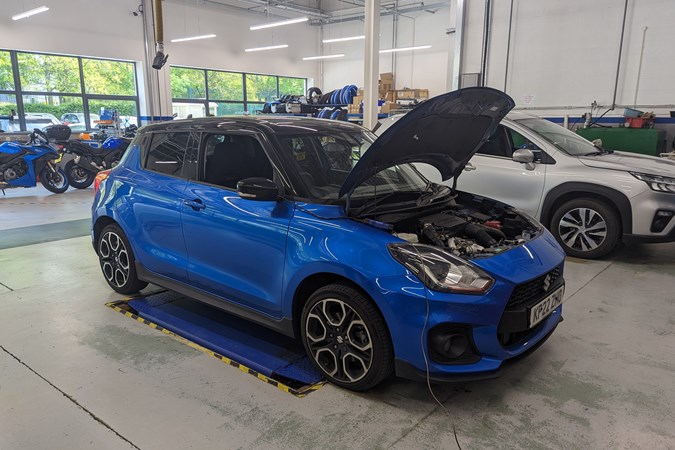
Maintenance. That’s an eleven-letter word that can strike fear into the heart of every hot hatchback owner. They’re fun cars that often get driven hard – so, when the time comes to take them to the workshop for a service, you lie awake at night worrying about how much your previous years’ worth of exuberant motoring will cost you.
Or at least you do with tatty hot hatchbacks from the 1990s. When I was a spotty-faced, cash-strapped youth, those were the cars my mates and I were tearing around in – and I have friends who have scrapped their cars rather than take them for a service because they knew the maintenance would cost more than its value.
In early May, the Swift Sport warned me its first service was due. I was expecting this to be quite an invasive process because its odometer is about to tick over to 10,000 miles. I’ve driven the length and breadth of Britain in the Swift – and one of my colleagues has even driven it to France and back. I was anticipating an oil and filter change, new spark plugs and maybe even a minor brake service. But when I arrived at Suzuki HQ, I was shocked by how little maintenance it needed.
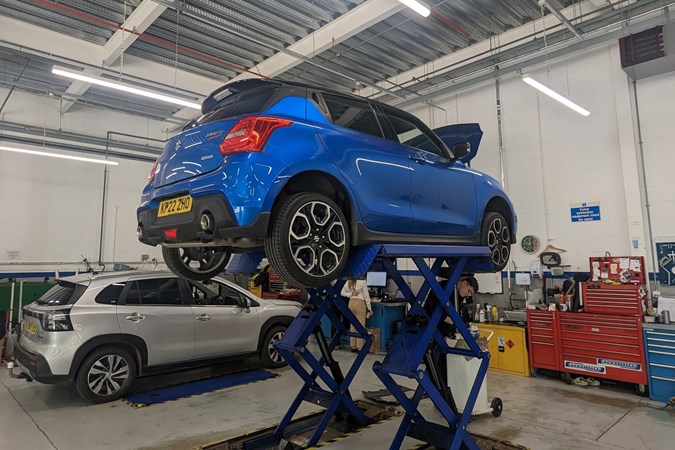
Now, I appreciate my surprise could be interpreted as fraudulent, but I’ve genuinely never watched a brand-new car receive a service. So, to frame my perception of vehicle upkeep, allow me to canter through the maintenance checklist for my own car. It’s a 1993 Rover Mini Sprite.
When it was on the road, every 4,000 miles I would replace the engine oil and filter, swap out the spark plugs, inspect the HT leads (and replace them if necessary), clean the air filter, replace the distributor cap and rotor arm (if a good scouring with a scrap of wire wool couldn’t save them), spanner check all the bolts holding the engine and subframes in place, grease the nipples (behave), check the brake and clutch fluid, check the coolant, assess the chassis for rust and finally get the strings out to make sure the alignment wasn’t too far out of kilter.
Suzuki’s mechanic changed the Swift’s oil.
Well, it was actually his apprentice that changed the oil. Suzuki’s master mechanic and I were too busy standing on the side lines, marvelling at how little maintenance modern cars require to stay healthy. Turns out he’s a fellow Mini owner, so he was well acquainted with the concept of owning a car that needs to be kept on life support.
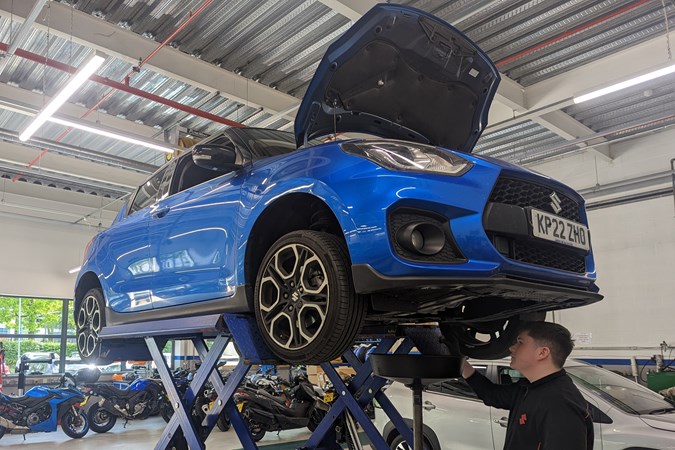
After the oil change, Suzuki’s technicians loaded some new software into the Swift’s infotainment system. I was grateful for this because Android Auto hasn’t been very reliable over the past few weeks. It’s had a habit of cutting out, normally when I’m in an unfamiliar town and relying on Waze for navigation. I know my phone isn’t at fault, either, because Android Auto works perfectly well in all the other cars I’ve tested. Suzuki says the new software will remedy the issue, but I’ll let you know how I get on.
Suzuki also took the opportunity to bring me up to speed on its new warranty scheme – and it seems the brand is tired of languishing at the bottom of the league tables. The company has increased its warranty offer from three years/60,000 miles to seven years/100,000 miles. That’s significant, thrusting Suzuki into joint second place in the new car warranty market alongside Kia and MG.
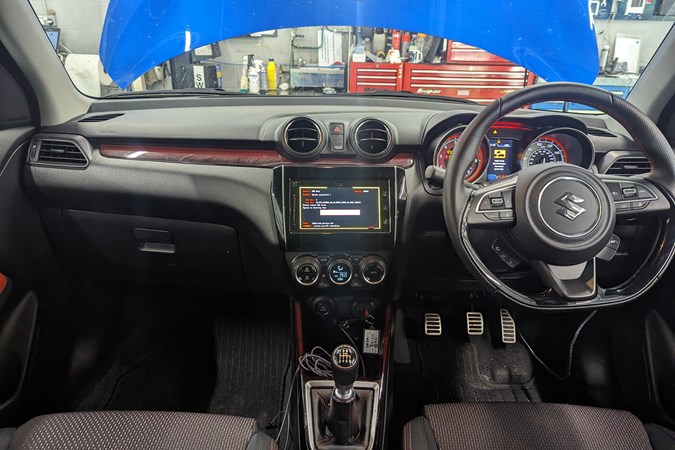
Like Toyota’s 10-year warranty package, Suzuki’s new deal starts as a three-year agreement, but the brand will extend it by 12 months every year you take it back to a registered Suzuki dealership for a service. And if you sell your car within the seven-year period, the warranty can be transferred to the new owner for free.
It’s a great new offer from Suzuki that I’m sure will translate into more sales for the company and slightly higher star ratings in our future reviews. Considering how low-maintenance its cars are, I can’t see the decision costing the company a great deal of money, either.
Mileage: 9,551
Average fuel economy: 45.2mpg
Update 5: Continental Swift
Report by Tom Wiltshire

I’ve given up flying to France. It requires two hours to drive to Heathrow, two hours waiting at the airport, a further hour with inevitable BA delays and finally just over an hour in the air. In the same time I could have driven down to Folkestone, hopped under the Channel and be most of the way down the autoroute to Paris – with no luggage allowances, no middle seats, and less outlay than a last-minute flight, even with petrol taken into consideration.
That’s the logic I took when attending a Renault event at the brand’s Aubevoye headquarters in Normandy – and given that my own long-term tester at the time was not fun to do long journeys in, I found myself requisitioning Luke’s Swift Sport.
The Swift wouldn’t be most people’s first choice for an extended journey, but I like it for a few reasons. First, there are so few cars around these days with a manual gearbox of any description that it’s a genuine pleasure to drive one. Second, the Swift’s definitely a ‘warm’ hatchback rather than one of the rock-hard abs brigade populated by the likes of the Fiesta ST, and as a result its ride is pretty forgiving – ideal for gruelling journeys like this.
Finally, though it wasn’t my primary concern, fuel economy in the Swift stubbornly refuses to dip below 45mpg when I drive it, so I was confident that the 700-mile round trip wouldn’t cost me the earth.
I’ve a personal soft spot for the Swift Sport, too. When I started out as a motoring journalist, this car’s predecessor was the first I ever drove around Millbrook’s Alpine handling loop – a rite of passage for young auto writers.
While I think the current model’s a bit less fun overall thanks to its turbocharged and mild hybridised engine, it’s still a byword for affordable enjoyment.
Imperfect but lovable
A few minor issues display themselves as soon as I set off in the Swift Sport. I’m blessed with child-bearing hips and they don’t play particularly well with the narrow sports seats fitted – as a result, I’m sat on top of the bolsters rather than between them. The solution, I find, is to lower one hip into the seat and rest my opposite thigh along the top of the outer bolster – a position which actually gives more support to my accelerator foot.
The Swift’s infotainment screen has always been a bit crap, but it turns out that my polarised sunglasses interfere with the display, and so there’s a big stripe down the middle that I can’t see. No matter, tilting the head aligns the pixels differently, so while I can’t see all of the screen at once, I can at least take note of the next turning on the sat-nav when I need it.
Finally, the central display simply refuses to stay put. I like a digital speedometer, but the one in the Swift is continually overridden every time it detects a road sign and displays it. Frustrating. I also couldn’t figure out how to – or indeed if it was possible to – change this from mph to km/h, so it’s lucky that the analogue speedo next to it has a tiny set of supplemental numerals for just such an occasion.
Still, the journey is a pleasure – I love how nippy the Sport is, and the fact it’s genuinely small. Darting down the narrow Eurotunnel train behind a BMW X6 makes me feel particularly smug, knowing that the Swift’s alloys are miles away from rubbing on the edges.
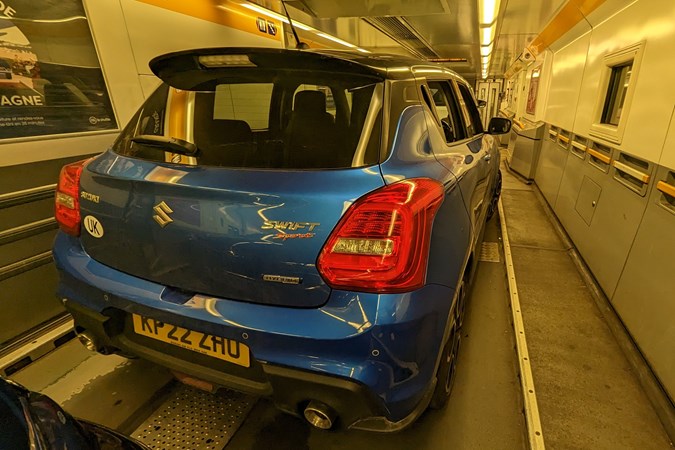
The Swift’s size also makes péage a little easier. The bane of any single traveller in a RHD car, paying French autoroute tolls involves parking up securely, sliding as much of your body as possible into the passenger seat and straining to reach the card reader. Then, setting off as quickly as possible, so that the battered Clio behind you doesn’t have a chance to get angry.
In a small car, there’s less reaching, and being able to see the Swift’s corners means I could pull closer to the booth in the first place. On the flip side, having a manual handbrake and a manual gearbox mean two bits of centre console debris waiting to impale you…
Off the autoroute, the Swift is as chuckable as I could want – it’s the sort of car that demands you drive everywhere with your foot pinned to the firewall, with the relatively modest power output ensuring that you’re unlikely to be going a silly speed while doing so.
The uneventful journey back after my Renault event includes a fuel stop – as predicted, the Swift’s been averaging 46mpg for the entire journey. It also includes a stop at a French supermarket for wine and cheese. That’s the real reason you drive rather than fly, isn’t it?
Mileage: 10,284
Average fuel economy: 46.1mpg
Update 6: lies and deceit
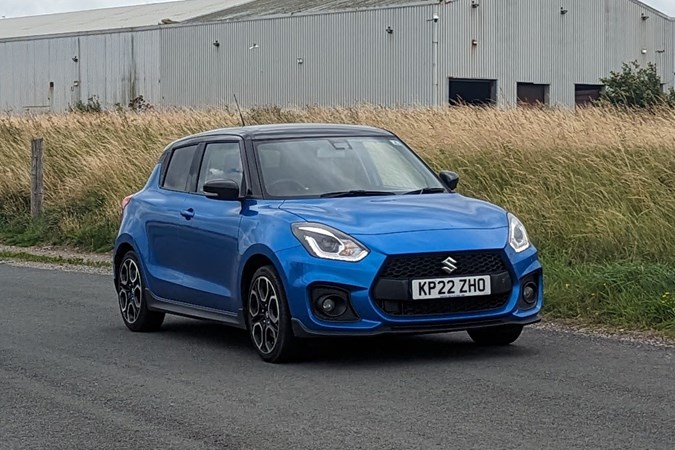
Suzuki lied to me. Its marketing material said the Swift Sport would sprint from 0–62mph in 9.1 seconds, but I’ve tested it and found that to be utter codswallop. Ever since I took delivery of the Swift, I’ve suspected it was much quicker than Suzuki was letting on – and it turns out I was right.
When I last was up north visiting my family, I borrowed a farmer friend’s private lane, switched off the Swift’s traction control and thrashed the living daylights out of the car to see how accurate Suzuki’s claims were. Within a few runs, I’d managed to achieve a 0–62mph time of 7.5 seconds.
What’s even more impressive is the Swift achieved that time in slightly damp conditions on a lane strewn with fine gravel. If I had a clean stretch of tarmac to give the Swift a little more traction off the line, I reckon I could have trimmed its 0–62mph time down to the seven-second mark.

So, why did Suzuki lie about the Swift Sport’s performance? Well, my best guess is that the company thought it was better to claim an easily achievable 0–62mph time rather than a potentially mechanically dangerous best-case scenario. I suppose it’s always better to over-deliver than under-promise.
There’s also quite a bit of skill (and, in my case, an equal amount of luck) required to get a 7.5-second 0–62mph time out of the Swift Sport on broken, soggy tarmac. My times varied wildly depending on how well I could get the front wheels to grip and how accurately I shifted gear. If I messed up the launch and the 1-2 shift, for example, I’d struggle to match Suzuki’s official figure.
But this is part of what makes the Swift such a fun car. You need to work hard as a driver to get the best out of it. In fact, I reckon I’ve learned more about car control during the past seven months of driving this little Suzuki than I did when I drifted Lamborghinis around a frozen field, simply because I’m not relying on the car for the performance.
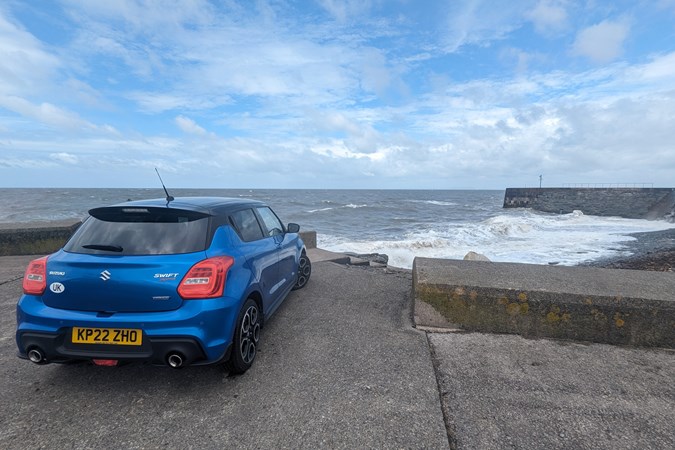
Lamborghinis can yawn out huge powerslides and heart-stopping 0–62mph times because they have enormous reserves of power. It doesn’t matter if you spin a Huracan’s wheels off the line or change gear too early in the rev range. They have more than enough poke to hide your clumsiness.
But Suzuki Swift Sports only have 129hp. That means, if you want to go quickly in one, you need to train yourself to use every single one of its horses effectively. There’s no room for error.
Mileage: 11,782
Average fuel economy: 44.9mpg
Update 7: Farewell
All good things must come to an end – and I’ve finally parted ways with my beloved Swift Sport. So, I thought I’d take the opportunity to reflect on the things I think Suzuki did well with the car and offer some constructive criticism on its biggest foibles.
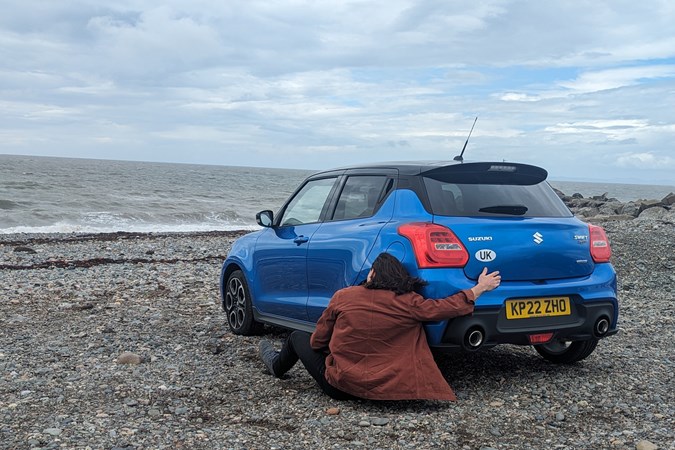
This is it, then. The end. I’ve cared for this little Swift Sport for seven months, but now it’s time for it to head back to Suzuki. Needless to say, I’m rather upset – I’ve grown very accustomed to the car and was already dreaming of the modifications I would do to make it my own before the collection date arrived and wrenched me back to reality.
My willingness to modify the Suzuki may come as a surprise to you as, when I took delivery of it in December 2022, I said it offered everything I look for in a car. I still think it’s a brilliant motor – but, with seven months of driving under my belt, I now feel like I’d need to make some changes if I were to keep the car any longer to make it better suit my tastes. Happily, my list of changes isn’t that extensive, though.
First off, I’d make it louder. Much louder. The Swift Sport’s exhaust has far too many baffles in it and its turbo barely makes a chirp until you load it up to the max by thrashing up a steep fell with a boot full of luggage and four passengers on board. I think hot hatches should be a little bit offensive – and the Swift is just too politically correct for my liking.
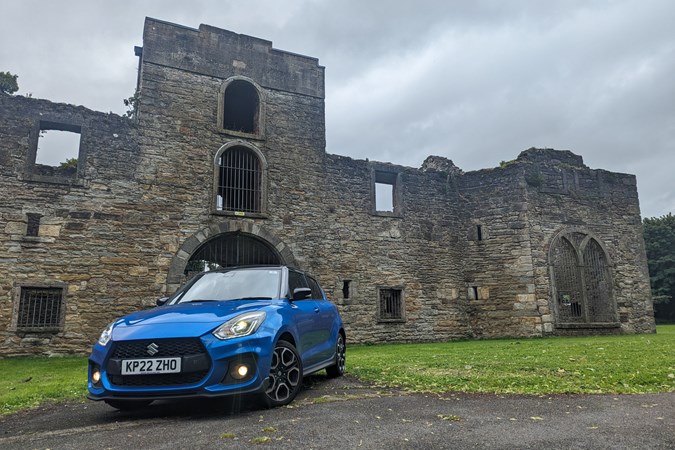
If it was my car, I’d throw the stock exhaust away and fit an aftermarket system consisting of little more than some two-inch tubing and a tiny rear silencer (if I’m lucky). I’d also fit a less restrictive air intake to allow the turbo flutters to be heard over the engine. And yes, I know every car mechanic reading this will be scowling at their screens, screaming: “noisy exhausts and aftermarket intakes kill horsepower!” But I don’t care – engine sounds are as important as performance in my book.
Purists will be happy to learn that I wouldn’t mess with the Swift Sport’s suspension, though. All my mates fall foul of this – they slam their cars into the weeds and then complain they don’t handle or ride properly anymore. The Swift’s suspension is damn-near perfect, offering just enough suppleness to be comfortable on the motorway, but enough rigidity to keep it flat in the corners. Top marks from me in that category, Suzuki.
I was less impressed by the Swift’s infotainment system. If it were my car, I’d rip it from the dashboard with my bare hands like Mola Ram from Indiana Jones and the Temple of Doom and watch gleefully as the life fades out of its circuits. It’s been a constant source of irritation during my time with the car due to its inability to retain its connection to my phone.
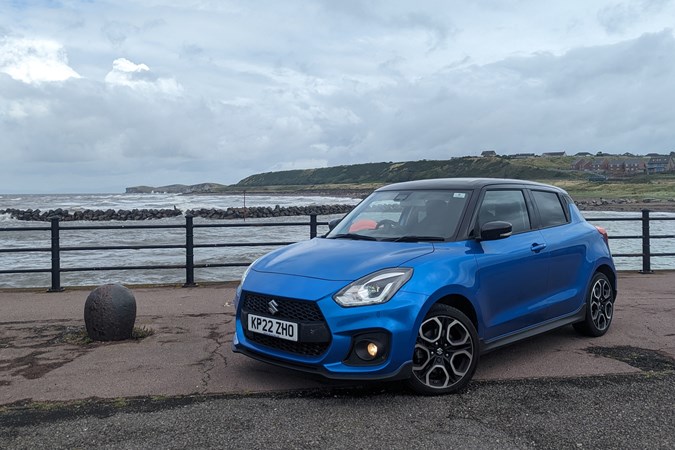
Even Suzuki couldn’t fix the problem. A week after I took the car back to the company’s press garage for a service and a software update, the screen once again forgot how to connect to Android Auto, leaving me stranded in an unfamiliar part of southeast England with little more than my wits for navigation. I’d swap it for the Pioneer unit in our best car stereos round-up.
The last tweak I’d make would be some sound deadening. I love how light the Swift is but when you’re bombing down the motorway, it’s a bit like sheltering from a hurricane in an allotment shed. It’s quite noisy. I like to listen to heavy metal when I’m driving, but the Swift’s tinniness means I need to set the stereo to its maximum volume to hear Saxon’s chugging riffs over the wind and road noise. That normally renders me deaf by the end of my journey.
I don’t think it would take a great deal of effort to fix the problem, either. I’d just add some Dynamat to some of the larger panels to dampen some of the panel vibrations and pad the door seals with some thin rubber hose to block out more of the wind noise.
It’s a loss, but I’m optimistic about the future
Criticisms aside, I still love the Swift Sport – and saying goodbye to a loved one is never easy. My despair was worsened by the news that my replacement vehicle would be a dull, grey, automatic SUV. But instead of viewing my loss as a goodbye, I’m trying to treat it as more of a ‘see you soon.’
Suzuki will replace the Swift in 2024 – and there’s a fresh version of the Swift Sport already in the pipeline. Rumours suggest it’ll be a real firecracker, too, with an even sharper chassis, the same approach to lightweighting and a much more potent 160hp mild hybrid petrol engine.
Now that the Fiesta ST is dead, these changes might be enough to put Suzuki close to the top of the small hot hatchback market. It still won’t be the fastest in its class – even if Suzuki builds it from carbon fibre and feathers, it won’t have enough poke to outstrip the fire breathing Hyundai i20 N in a straight line. However, I’m hoping Suzuki will compensate for that by keeping the Swift Sport fun.
Like the current car, the next Swift Sport will be at its best if you can exploit all its performance on your morning commute without losing your licence. I also hope the car won’t be stifled by too many electrical safety nannies – and I’m sure I’ll adore it if Suzuki’s development team can factor in my concerns about the car’s asthmatic exhaust note and lacklustre turbo flutter.
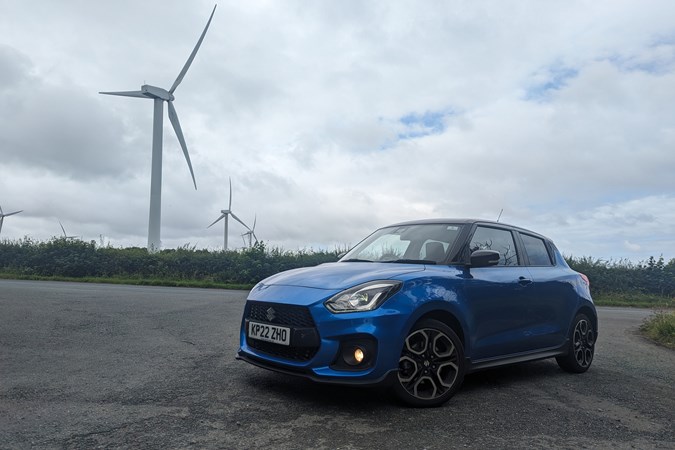
Manufacturers have sunk into a statistic-chasing rhythm, particularly now that we’ve entered the era of electrification. We’re at the point where an electric family saloon like the Tesla Model S can blow the doors off the fastest Lamborghinis and Ferraris in a straight line, which is wrong in my book.
Electrification shouldn’t be an arms race, especially in the lowlier car segments. In the case of normal cars like the Swift, I think it should be deployed to extend the petrol engine’s practical lifespan as far into the future as possible, allowing the next generation of petrolheads to experience at least some of the joy we did in the early stages of our motoring career. EVs are very impressive, but the anticipation of watching your rev counter climb as you wait for your turbo to kick in? That’s fun.
I trust Suzuki to do the right thing. By the time the next decade rolls around, it could be one of the last manufacturers championing the analogue driving experience, as its peers march towards EVs and autonomous motoring. For that reason, it’s one of the few car makers I’m still excited about. Roll on next year. I can’t wait for the Swift Sport’s follow-up act.
Mileage: 12,152
Average fuel economy: 44.7mpg
| Current mileage | 12,152 |
| Real-world average fuel economy | 44.7mpg |
| Official combined fuel economy (WLTP figures) | 47.0–50.4mpg |
| Parkers MPP (Miles Per Pound) calculation | 6.9–7.4 |
| Car joined Parkers fleet | December 2022 |



